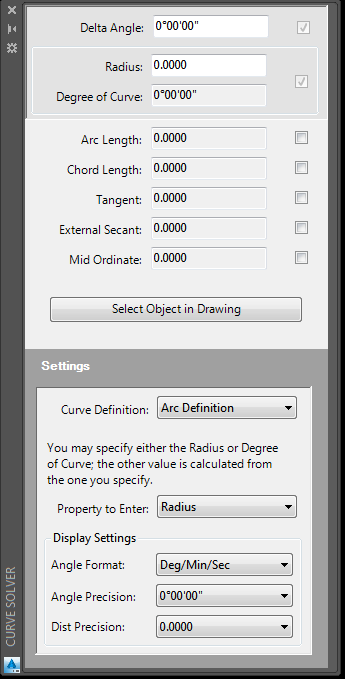SincpacC3D
General Information
Command Summary

CurveSolver
|
SincpacC3D
General Information
Command Summary
CurveSolver |
Description
The CurveSolver tool lets you key in two values for a curve, and solve for the remaining values.
Usage
Type CurveSolver at the command line, and the following palette will appear (the first time the palette is displayed you may need to resize it slightly in order for it to show correctly. This is a .NET API issue):

At the bottom of the palette are the settings (resize palette by dragging the lower right corner down to display the settings) with an option to specify whether the Arc Definition or Chord Definition should be used. In addition, it allows you to toggle between specifying the Degree of Curve and the Radius. Below that are toggles that control the precision of the displayed values, as well as the desired format for the angles.

The Curve Solver displays eight different values. You may select two values to specify, and the remaining values are calculated. You may select any two values, except at least one of the selections must be from the shaded values (i.e., Degree/Radius or Delta).
Note that when displaying the angle in one of the DMS (degree/minute/second) formats, you may key in values in any of the allowed DMS values. For example, in the animated image below, the value "25.2525" is keyed in as the angle. When the angle units are set to Decimal Degrees, the "15.2525" is interpreted as 15.2525 decimal degrees, or 15�15'09". When the angle units are set to DMS format, the "15.2525" is interpreted as 15�25'25". (Please note that this tool was converted from a Windows Form to a Palette, so it now looks slightly different than this example.)
